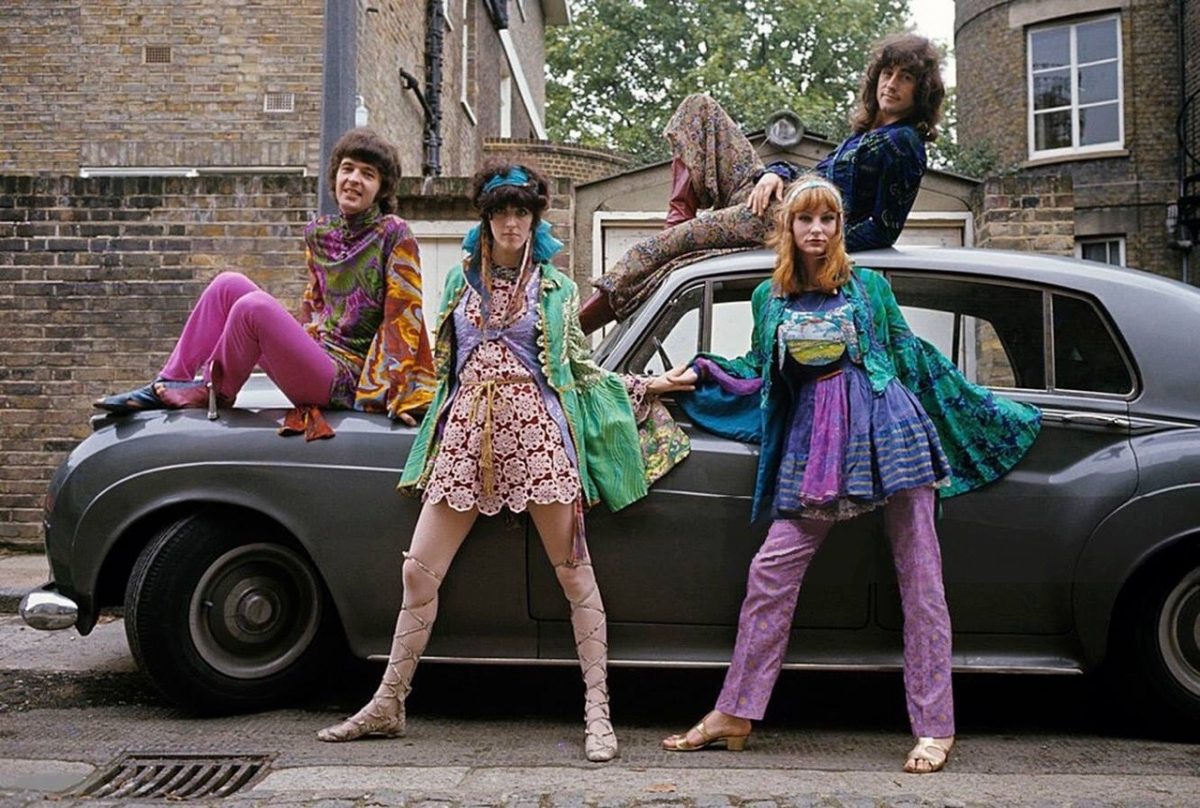Hippies (derived from the word hipster) were the natural outgrowth of the Beat movement in the 1950s. They were interested in an alternative lifestyle and rebelled against an increasingly conformist and repressive society and aimed for freedom and a return to nature.
1960s fashion reflected youth. From the short children's skirts of the mid-1960s to hippie dresses, clothes acquired new lines, new colors and the expression of a vibrant optimism mixed with an idealistic desire for a new egalitarian society.
The Best 60's Hippie Fashion for Women in California
Growing feminist attitudes and the "free love" mentality within hippie culture have led to an increase in androgyny and rule breaking. Hippie women could, and often did, wear men's clothing.

Image Source: google.com
Men's T-shirts and pants were comfortable, as were oversized jackets and shirts. The work was easily transformed into mini dresses.
Makeup was rare, bras were optional, and personal hygiene was minimal. In the late 1960s, women wore shirts that were tied or cut to expose their midriffs. Among hippies, it was an "anything goes" era.
On the more feminine side, women's hippie fashion featured dresses and long skirts with ruffles. straight back and wide beach pants. They were made of lightweight fabrics, such as cotton or linen, and were usually in bright solid colors or printed with ethnic designs.
Read Also: Know More about Hairstyles for Over 50 And Overweight
Plain, simple column dresses of the period At the beginning of the 20th century, they were purchased in antique shops and flea markets, without taking into account the narrower and shorter silhouette of the 1960s.
In dresses, Bishop sleeves and exaggerated bell sleeves were popular in the hippie style. The style must be maintained. Messy style. Trend towards loose and fluid fabrics. This also applies to screen-printed peasant blouses, kimono shawls, ponchos and shawls, with the added benefit of being more versatile than dresses.
A trend has emerged among flower children. new feminine style that has its roots in activism, return to nature movements and yoga. The "Mother Earth" look added an American twist to the diverse influences of hippie fashion.
Your 60's Hippie Outfit Fashion Tips 2024
When creating a hippie outfit, it's important to consider when. For a first hippie look, simple clothes with a more masculine silhouette are suitable, such as trousers and a knitted sweater. All you need is a scarf and some daisies to create the Protestant student look.

Image Source: google.com
However, the sweater remains the same piece from 1969. It must be oversized and the trousers should be large or non-existent. Additional necklaces, a hat and perhaps an embellished scarf or bandana would be ideal accessories for years to come.
There were "disco hippies" in psychedelic minidresses, bell sleeves and go-go boots, but not as many as Halloween costume designers think. It was unlikely to be seen in the hippie movement, but instead served as mod or disco style hippie-inspired clothing.
As if these colors and patterns were going for amazing , I see myself popular between 1966 and 1968, some festival goers used it and mixed it with other less modern accessories.
The style of dressing a hippie girl "in Instead of the mainstream, Hing relied entirely on his commitment to the movement, his style, his creativity and his budget. long, flowing whites with a striking lapel on the front.t0 in 1967 and gained popularity eventually of the 70s.
Hippie Style
Hippie clothes were once loose and made with natural fibers such as cotton and hemp. Both men and women left their hair long and avoided complicated products and styles (although, contrary to popular belief, they still did so with shampoo). The black turtlenecks and slacks worn by beatniks, both men and women, were transformed into peasant blouses and jeans. Anything that was handmade, whether sewn, woven or macrame-woven, was prized. Gradually, this expanded to dyeing your own clothes, and the colorful tie-dye style became popular.
Loose, hip-hugging jeans, preferably with fringes at ankle height. and flowerbeds could be seen everywhere. Peasant blouses, T-shirts or just a sleeveless top go well with jeans. The accessories were all handmade and many included peace symbols as the Vietnam War intensified.
Skirts and Dresses
In women's fashion of the 1960s, skirts and dresses had nothing to do with what you saw on the catwalks. Fashion hasn't changed this dramatically since the 1920s and young people defined what was acceptable. The hemlines that shocked conservatives in the 1920s nearly gave some people apoplexy in the 1960s, when girls with nice legs wore miniskirts and even microminiskirts. A short skirt was worn with knee-high suede boots in cold weather or with sandals on hot summer days.
Related Post: The Best of Taylor Swift Kansas City: A Local's Guide
The dresses were short and covered the body, or they were long and loose peasant or grandmother's dresses. A peasant dress reflected a Renaissance girl, and flowing ribbons in her hair and dress often enhanced the look. Of course there were also flowers.
Popular Models
Two of the most popular models Dresses hippies The most popular were floral and dip-dyed, but there were others who appeared again and again in their free-spirited outfits that they wore. There were usually many colors and the clothes could contain:
Psychedelic Designs
Op art
Paisley
Stripes (to the bottom of the bell)
Flower Power
We've talked about it so much that it's now a cliché or even a joke , but the flowers were very symbolic of the hippie movement. Nothing represented peace and love more than a flower, and they were everywhere. Floral prints were popular on blouses and dresses, and floral patches adorned skirts and jeans. They wore real flowers in their hair and floral designs were painted on their faces. Hippies argued that, given the ugliness of the world, it was important to show as much natural beauty as possible.
Hippie Accessories

Image Source: google.com
Simplicity was key to hippie fashion in the 1960s. Women's jewelry was largely handmade or influenced by Native Americans or similar creations derived from nature. Beads were very popular, as were any peace sign necklaces. Since music was a big part of the hippie scene, jewelry that played music was sought after. Some women wore necklaces with bell-shaped pendants, and many wore jingle anklets. In general, much attention was paid to the ankles, as many hippies, especially those who lived on the warm West Coast, preferred to go barefoot. It was not a popular time for pedicures.
The hippie influence
Although it I did At that time, it was the first time in the history of fashion that a youth movement influenced the clothing industry and exerted the strongest influence. Fashion designers have largely followed the lead of young people, and most American women should never again let themselves be led by the fashion industry. Trends continue to come and go, but the women who found their style and individuality in the 1960s never gave up and passed much of that style onto their daughters.
Frequently Asked Questions!
What Clothes Did Hippies Wear in the 1960s?
Baggy pants and similar baggy trousers are still very popular today, especially loose denim and velvet trousers. or velvet - Flat trousers. Featuring a high neckline and long sleeves, the granny dress was very popular among hippies and was often paired with large, rimless "granny" glasses.
What Were the Fashion Trends for Hippies?
They usually wore long, flowing clothes, such as bell-bottoms elephant, peasant skirts, tunics and caftans. . . These dresses were made with the most colorful fabrics or with macramé prints. Under these layers they usually wore stockings or leggings and accessorized large jewelry or feathers in their long hair.
What Were Hippies Like in the Early Years? 60?
They experienced communal or cooperative lifestyles, often followed a vegetarian diet based on unprocessed foods, and practiced holistic medicine. Hippies were also known for their unique style, preferring long hair and casual, often unconventional clothing, sometimes in "psychedelic" colors.
What Did Hippies Eat in the 60s?
The cuisine that the counterculture took over in the late 60s and which has then contributed to shaping and generalizing it. in the 1970s whole grains and legumes were introduced; fresh and organic vegetables; soy foods such as tofu and tempeh; nutrient enhancers such as wheat germ and sprouted cereals; and flavors of Eastern Europe and Asia.
Did the Hippies of the 60s Wear Makeup?
Seriously? When it comes to eyeshadows, lipsticks, clothes and blush, is it possible to give up foundation, concealer, bronzer, glitter, highlighter and just a little hippie freshness? Absolutely. Many hippie women didn't wear makeup in the 60s and 70s.
